Curious about divine fury? Explore the most awe-inspiring examples of God's wrath in the Bible and their profound lessons for our lives today.
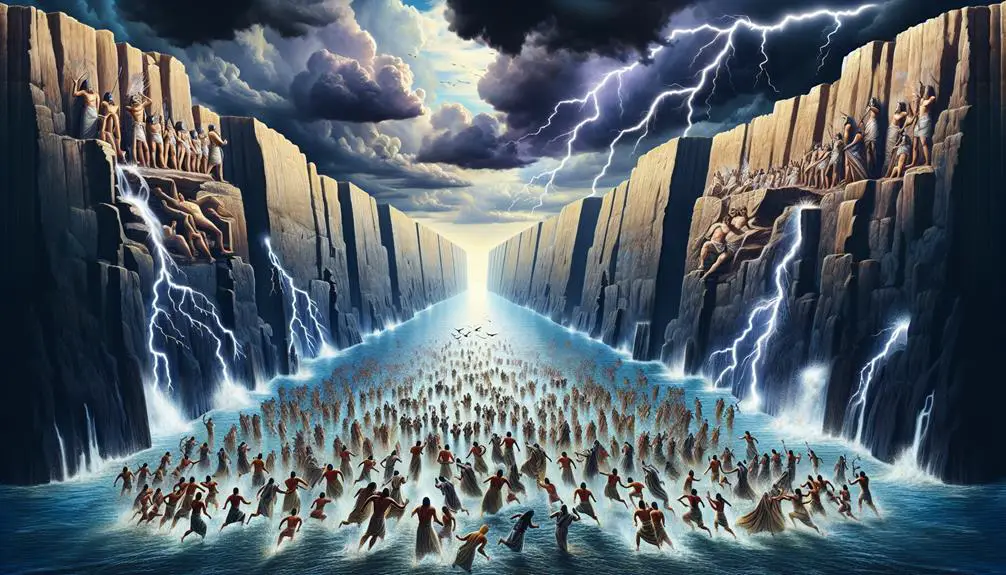
Examples of the Wrath of God in the Bible
Imagine scrolling through your social media timeline, only instead of memes and status updates, you're witnessing live updates of the Great Flood or Sodom and Gomorrah's fiery downfall.
The Bible's loaded with instances where God's wrath reshapes the course of human history, from plagues in Egypt to the earth swallowing rebels whole.
You've probably heard these stories, but have you considered their implications or the lessons they carry for us today? Let's embark on a journey through these ancient narratives to uncover their significance in our modern world, and perhaps, find out what they mean for you personally.
Key Takeaways
- Divine wrath often follows human wickedness and moral decay, as seen in the Great Flood and Sodom and Gomorrah.
- Divine judgment balances justice and mercy, offering protection and a chance for repentance to the faithful.
- Stories of divine intervention highlight the importance of moral accountability and the consequences of one's actions.
- Leadership challenges against divine order, like Korah's rebellion, underscore the gravity of insubordination and its repercussions.
The Great Flood
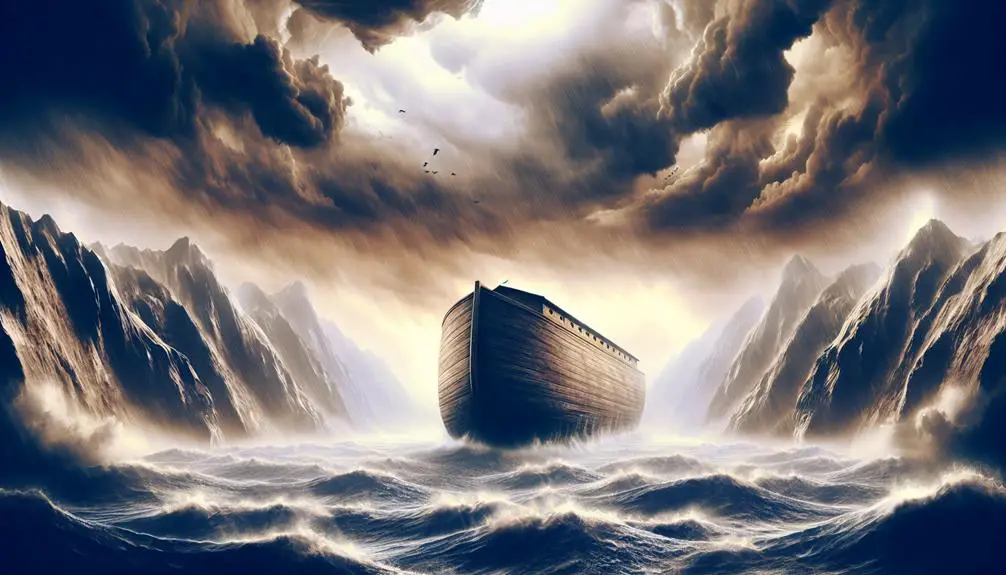
In examining the narrative of the Great Flood, it's crucial to recognize its role as a manifestation of divine wrath in response to human wickedness, fundamentally altering the course of humanity's relationship with the divine. This story, rich in symbolism and moral lessons, showcases how Noah's obedience serves as a beacon of faith amidst widespread corruption. His compliance to divine commands, including the gathering of animal pairs, underscores a covenant between God and humanity, mediated through Noah's righteous actions.
You'll find that Noah's adherence to divine instructions not only saved him and his family but also preserved the continuity of life on Earth through the animal pairs. This aspect of the narrative emphasizes the importance of obedience and faith in the face of impending doom. The animal pairs, representing life's diversity and the potential for renewal, symbolize a new beginning. It's a profound reminder of the interconnectedness of all living beings and the responsibility humans hold towards creation.
Moreover, the Great Flood narrative challenges you to reflect on the consequences of moral decay and the potential for redemption through righteous living. Noah's story isn't just about survival; it's a testament to the possibility of finding favor in the eyes of the divine through unwavering faith and adherence to moral principles. It invites you to consider the dynamics of divine justice and mercy, inviting a deeper understanding of the divine-human relationship.
In this context, the Great Flood serves as a pivotal moment in biblical history, highlighting themes of judgment, salvation, and covenant that resonate through the ages. Noah's obedience and the preservation of animal pairs become symbols of hope, renewal, and the enduring promise of divine fidelity.
Sodom and Gomorrah
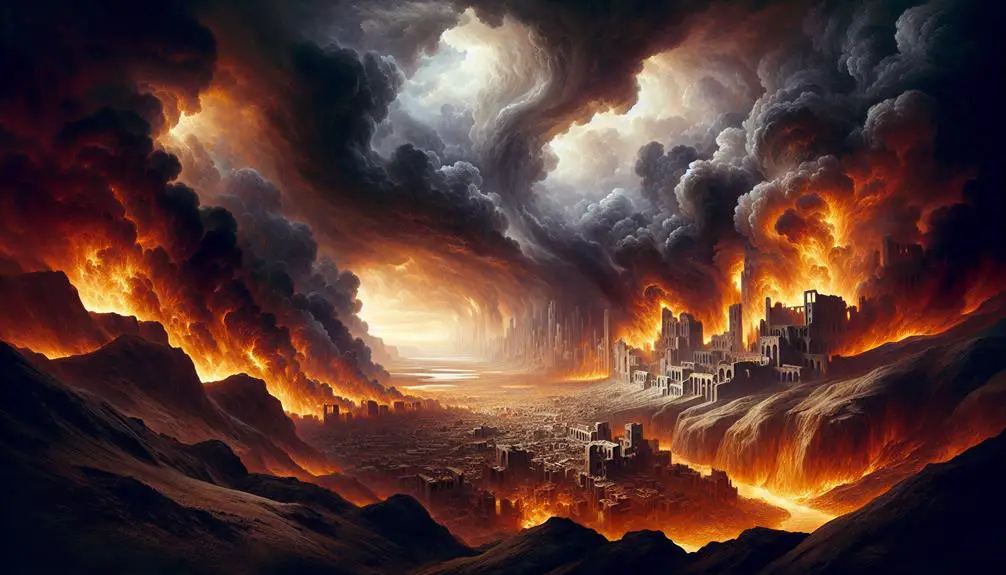
As you explore the narrative of Sodom and Gomorrah, you'll encounter a pivotal example of divine judgment manifested, a theme that resonates throughout the biblical text.
The story intricately weaves the angels' warning to Lot, highlighting the interplay between divine foreknowledge and human agency.
Divine Judgment Manifested
Reflecting on the biblical narrative, one finds that the story of Sodom and Gomorrah serves as a profound example of divine judgment, showcasing the consequences of moral decay and the wrath of God. This narrative isn't just a tale of destruction; it's a multifaceted reflection on God's mercy and the significance of prophetic warnings.
Before the judgment was executed, these cities were given opportunities to amend their ways, illustrating that divine judgment isn't impulsive but a considered response to persistent wrongdoing. This aspect of the story prompts you to ponder the balance between divine justice and mercy, urging a reflection on the importance of heeding warnings and the inevitable consequences of ignoring them.
The destruction of Sodom and Gomorrah thus stands as a stark reminder of the seriousness with which divine commands and warnings should be taken.
Angels' Warning to Lot
Delving into the narrative of Sodom and Gomorrah, we observe that the angels' warning to Lot epitomizes a pivotal moment of grace amidst impending judgment. This episode strikingly showcases:
- Lot's hesitance: Despite the clear danger, Lot hesitates to leave, embodying the human struggle between attachment and salvation.
- Angelic protection: The angels not only warn but actively intervene, ensuring Lot's escape, underscoring divine mercy.
- A choice of urgency: Lot is urged to flee without looking back, symbolizing the pressing need for decisive action in times of moral crisis.
This story reflects a profound lesson on divine intervention and human responsibility. Lot's hesitance juxtaposed with angelic protection portrays a complex interplay of divine grace and human agency, offering a reflective lens on the nature of salvation and judgment.
Destruction's Aftermath Revealed
In the wake of Sodom and Gomorrah's obliteration, the biblical narrative unfolds a landscape of divine justice and human consequence, revealing profound insights into the nature of wrath and redemption. This aftermath isn't merely a tale of destruction; it's a canvas highlighting mercy's presence amidst judgment.
You're shown that even in moments of severe punishment, the divine doesn't abandon humanity entirely. Instead, repentance opportunities are woven into the fabric of the narrative, suggesting that redemption is always within reach for those willing to seek it. This duality between wrath and mercy underscores a critical theological point: divine justice isn't blind fury but a balanced scale, offering lessons for the present on how one might navigate the complexities of moral accountability and spiritual renewal.
The Ten Plagues
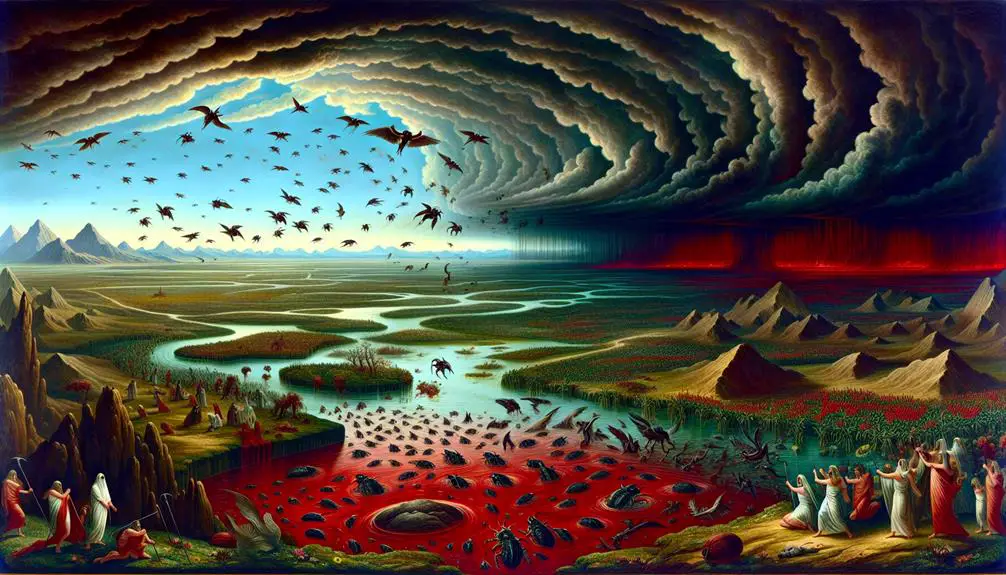
One of the most striking demonstrations of divine retribution in biblical narrative, the Ten Plagues showcase God's power and judgment upon Egypt for refusing to release the Israelites from bondage. Central to this narrative are Moses' leadership and Pharaoh's stubbornness, elements that set the stage for a dramatic confrontation between divine will and human resistance. Moses, acting under God's directive, repeatedly demands the release of the Israelite slaves, only to be met with Pharaoh's hardened heart. This dynamic underscores a critical theme: the consequences of defying divine commandments.
The Ten Plagues, as described, aren't merely punitive measures but also serve as profound demonstrations of God's sovereignty over creation, challenging Egyptian deities and Pharaoh's perceived divinity. Each plague escalates in intensity, reflecting a systematic dismantling of Egypt's economic, social, and religious structures:
- *Water turning to blood* devastates the Nile's ecosystem, striking at the heart of Egypt's agricultural and spiritual life.
- *The plague of frogs* invades homes and temples, disrupting daily life and mocking the Egyptian god Heqet.
- *The death of the firstborn*, the final and most severe plague, symbolizes the ultimate judgment against Pharaoh's intransigence, compelling the release of the Israelites.
This sequence not only showcases the might of God but also serves as a narrative of liberation, emphasizing the lengths to which divine justice will go to free the oppressed. Reflecting on the Ten Plagues invites contemplation on themes of power, resistance, and deliverance, underscoring the biblical portrayal of God as both protector and punisher.
The Swallowing of Korah
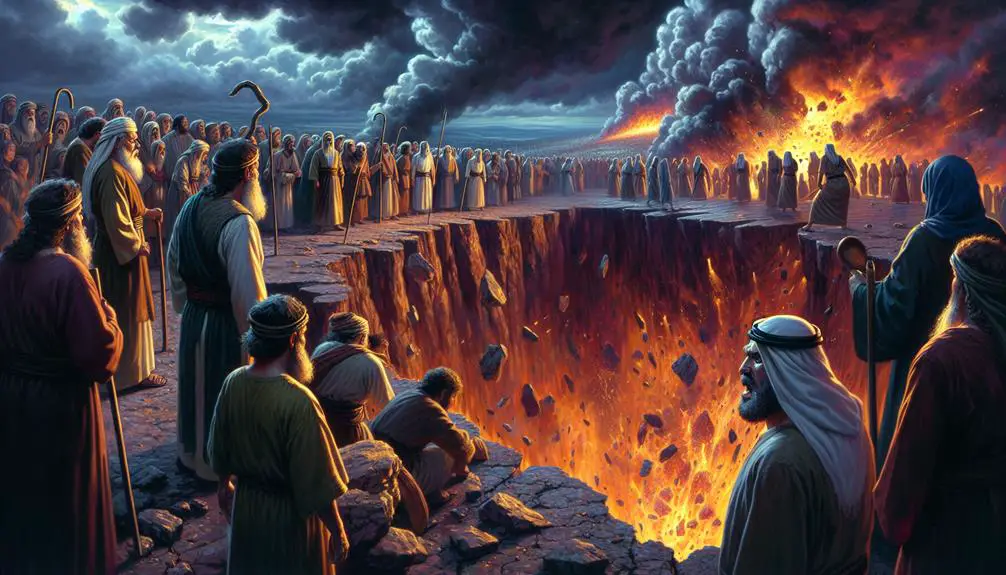
You'll find the narrative of Korah's rebellion against Moses not just a historical recount but a profound demonstration of divine justice and authority.
In scrutinizing Korah's actions and the subsequent divine punishment, one observes a clear delineation between human ambition and divine will.
This incident serves as a pivotal example of how defiance against divinely appointed leadership is met with unequivocal consequences, reflecting broader themes of obedience and rebellion within the biblical text.
Korah's Rebellion Detailed
Korah's rebellion, as detailed in the Bible, starkly exemplifies the consequences of defying divine authority through its dramatic culmination in the earth swallowing Korah and his followers. This event not only underscores a leadership challenge but also elicits a significant community response. Analyzing this narrative, one can discern:
- The audacity of Korah and his co-conspirators in challenging Moses' leadership, which represents a direct affront to the divine order established by God.
- The immediate and collective backlash from the community, highlighting the societal norms and expectations regarding obedience and respect towards established authority.
- The eventual divine intervention that serves as a harrowing reminder of the ultimate authority God holds over His creation, emphasizing the peril of insubordination.
Reflecting on Korah's rebellion offers profound insights into the dynamics of leadership, authority, and divine justice.
Divine Punishment Executed
The execution of divine punishment on Korah and his cohort, marked by the earth's dramatic opening to swallow them whole, serves as a stark manifestation of divine retribution against rebellion. This event isn't merely about punishment; it's a profound lesson in moral accountability and the limits of divine mercy. You're prompted to reflect on the gravity of actions and their consequences.
Aspect |
Significance |
Reflection |
|---|---|---|
Divine Justice |
Demonstrates the seriousness with which rebellion is handled. |
How do we respect authority? |
Moral Accountability |
Underscores the responsibility of individuals in their actions. |
How do we hold ourselves accountable? |
Divine Mercy |
Highlights the limits of mercy in the face of persistent defiance. |
How do we understand mercy's bounds? |
This narrative serves as a reminder that while mercy is a divine attribute, it's accompanied by an expectation of righteousness.
The Destruction of Jericho
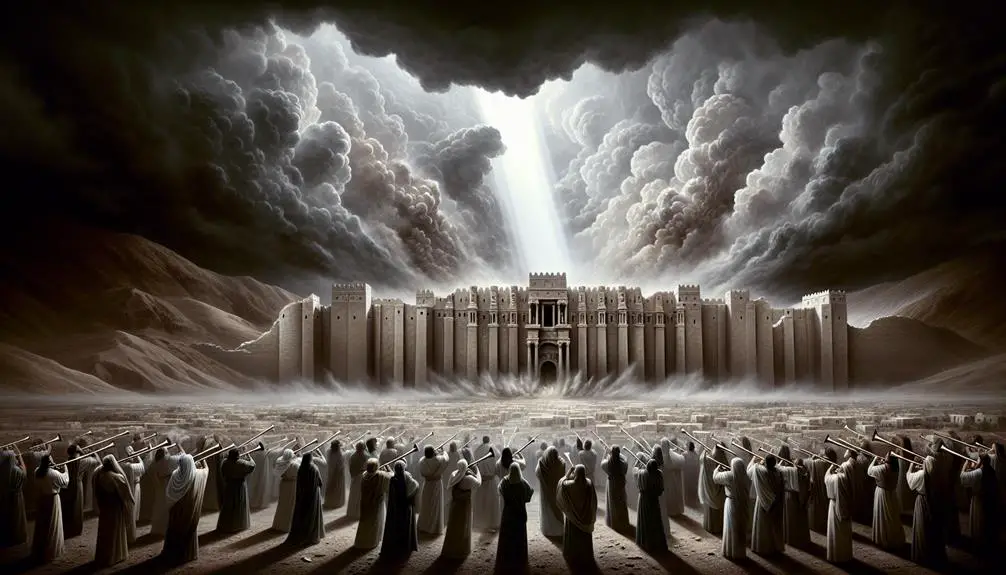
In an act of divine judgment, God's command led to the complete destruction of Jericho, marking a pivotal moment in biblical history. Under Joshua's leadership, the Israelites witnessed a demonstration of power that underscored both the severity of divine wrath and the protection afforded to those who remained faithful. This event not only symbolizes the fulfillment of a divine promise but also ignites archaeological debates regarding its historical and spiritual implications.
The narrative of Jericho serves as a critical juncture, illustrating:
- The obedience of Joshua and the Israelites, who followed God's instructions meticulously, demonstrating unwavering faith in the face of seemingly insurmountable odds.
- The strategic use of divine intervention, where the walls of Jericho fell not by human strength but by the power of God, showcasing a supernatural event that defies natural explanation.
- The moral and ethical conundrums it presents, challenging readers to reflect on the nature of divine justice and the complexities of historical religious narratives.
This destruction, while a testament to the might and judgment of God, opens a dialogue on the nature of archaeological evidence and its role in affirming or questioning biblical accounts. The debate surrounding the historical accuracy of this event underscores a broader discussion on faith, evidence, and the interpretation of ancient texts. Reflecting on Jericho compels us to consider the intersection of divine action and human history, inviting a deeper exploration into the ways in which sacred narratives shape our understanding of the past.
The Plague of Snakes
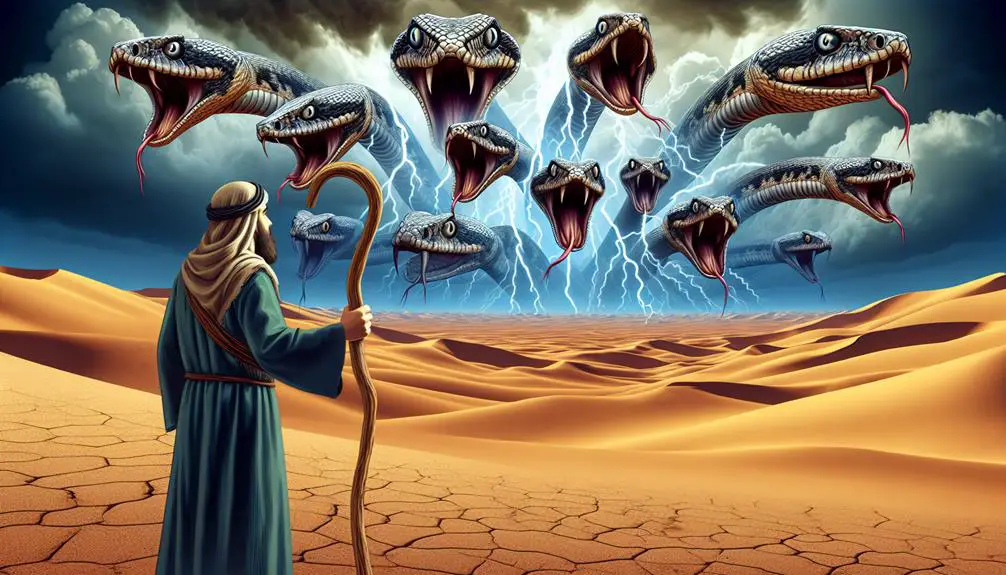
Reflecting on the destruction of Jericho as an act of divine judgment, we're compelled to explore another significant biblical episode: the plague of snakes, a narrative that further exemplifies God's power to both punish and protect. This event, deeply ingrained in the collective consciousness of the Israelites, symbolizes a pivotal moment of divine wrath and mercy intertwined.
In this account, the Israelites' complaints against God and Moses prompt a severe but instructive response. The unleashing of venomous snakes among them serves as a stark manifestation of God's displeasure. However, the symbolism of the snake goes beyond mere punishment. It embodies the dual nature of divine interaction with humanity: a call to awareness and a guide towards repentance.
The snakes, while agents of death, also catalyze a transformation within the community. Faced with the consequences of their actions, the Israelites are driven to acknowledge their transgressions and appeal to Moses for intercession. This act of repentance is pivotal, illustrating a fundamental lesson: divine mercy is always within reach for those who genuinely seek it.
Moses' creation of a bronze snake, as instructed by God, and its subsequent role in the healing of those bitten, further underscores the theme of salvation through faith and obedience. Here, the snake transforms from a symbol of punishment to one of salvation, encapsulating the profound lesson that redemption is possible, even in the darkest of times.
This episode, rich in snake symbolism and repentance lessons, offers a profound reflection on the dynamics of sin, judgment, and grace. It reminds us that, amidst divine wrath, there lies an unwavering promise of redemption for those who turn back to God.
The Death of Ananias and Sapphira
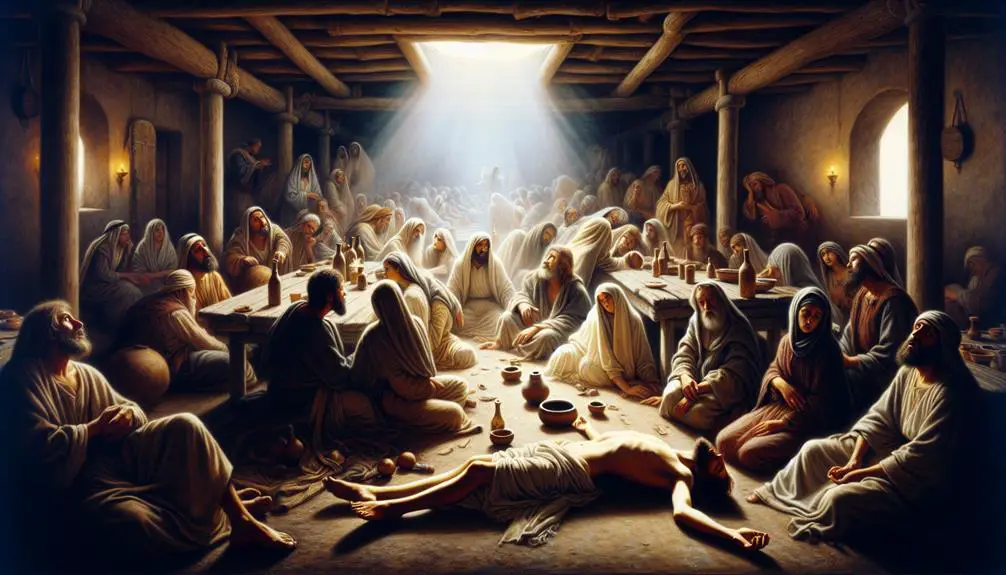
Amidst the narrative of early Christian community formation, the story of Ananias and Sapphira starkly illustrates the grave consequences of deceit and the importance of integrity in one's faith journey. This account, found in the Acts of the Apostles, serves as a poignant example of how the early Church navigated complex ethical dilemmas and enforced church discipline.
- Ananias and Sapphira decided to sell a piece of property, vowing to donate all proceeds to the community but secretly withheld part of the money for themselves.
- Upon confronting Ananias, Peter revealed that Ananias hadn't lied to men but to God. Immediately after this revelation, Ananias fell down dead.
- Sapphira, unaware of her husband's fate, later repeated the lie and met the same end.
This narrative isn't merely about the punishment of two individuals but delves deeper into the ethos of the early Christian community, underscoring the critical value placed on honesty and transparency. The swift and severe outcome faced by Ananias and Sapphira underscores the collective commitment to ethical integrity, a cornerstone for communal trust and spiritual fidelity.
The incident raises important questions about the role of church discipline and the handling of ethical dilemmas within a faith community. It prompts reflection on the balance between grace and accountability, challenging believers to consider the implications of their actions on the communal body. As such, the story of Ananias and Sapphira remains a compelling examination of the complexities of living out one's faith with integrity, marked by an unwavering commitment to truth.
Frequently Asked Questions
How Do Theologians Reconcile the Concept of a Loving God With the Instances of His Wrath Depicted in the Bible?
You're tackling a profound question that delves into the heart of the divine justice and love paradox. Theologians often argue that God's wrath isn't contrary to His love but a component of it, ensuring justice and righteousness.
They reflect on how a loving God disciplines, not out of spite but for correction and ultimate good. This perspective reconciles seemingly conflicting attributes by viewing them through a lens of holistic, divine purpose.
Are There Any Examples of God Showing Mercy or Restraint in His Wrath Throughout the Bible That Contrast With These Events?
Certainly, the Bible isn't just fire and brimstone; it's also filled with stories of mercy, like a river of hope flowing through a desert of despair.
For instance, in Noah's Ark, God's decision to save Noah's family and pairs of animals exemplifies His mercy amidst judgment.
Similarly, Jonah's Warning to Nineveh, where God relents from destroying the city following their repentance, showcases His restraint and willingness to forgive, highlighting a compassionate aspect of divine nature.
How Have Interpretations of God's Wrath in These Biblical Stories Evolved Within Modern Theology and Contemporary Religious Thought?
In modern theology and contemporary religious thought, interpretations of divine wrath have significantly shifted. Scholars and believers alike now often emphasize the psychological impact and cultural interpretations behind these narratives.
They reflect more on what these stories teach about human nature, justice, and mercy, rather than viewing them as literal expressions of divine anger. This nuanced approach encourages a deeper, more reflective exploration of faith and morality.
In What Ways Have These Stories of Divine Wrath Influenced Legal and Ethical Norms in Judeo-Christian Societies?
You're navigating a sea where legal precedents and ethical debates are shaped by towering waves of historical narratives. These tales, though ancient, have etched deep grooves into Judeo-Christian societies' legal and moral frameworks. They've not just influenced laws but stirred ethical debates, reflecting divine justice's shadow in societal norms.
Your reflection on these stories reveals their enduring grip on contemporary legal and ethical standards, underscoring their undiminished relevance and power.
Can Parallels Be Drawn Between the Biblical Examples of God's Wrath and Similar Narratives in Other Religious Texts or Mythologies?
You can certainly find parallels between biblical narratives of divine wrath and stories from other religious texts or mythologies. By delving into comparative mythology, you'll uncover a rich tapestry of cultural symbolism that reflects universal themes of justice, morality, and retribution across different societies.
This analytical exploration reveals how cultures use mythology to navigate complex ethical landscapes, illustrating the shared human experience of wrestling with the concept of divine justice.
Conclusion
In reflecting upon these biblical narratives, you witness the formidable nature of divine wrath, unfolding across earth and heaven like a tempest that reshapes landscapes and destinies.
Each story, from the deluge that cleansed the earth to the silent demise of Ananias and Sapphira, serves as a testament to the profound morality and justice that govern the cosmos.
These tales aren't merely historical footnotes; they're vibrant, cautionary tales that echo the immutable consequences of defiance against the sacred order.


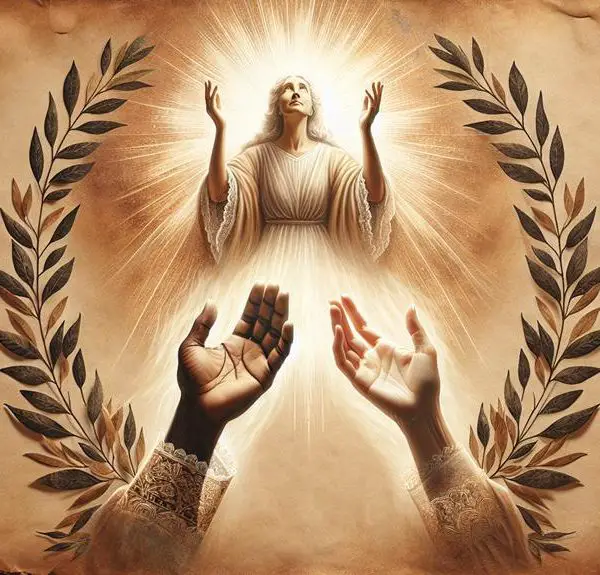
Sign up